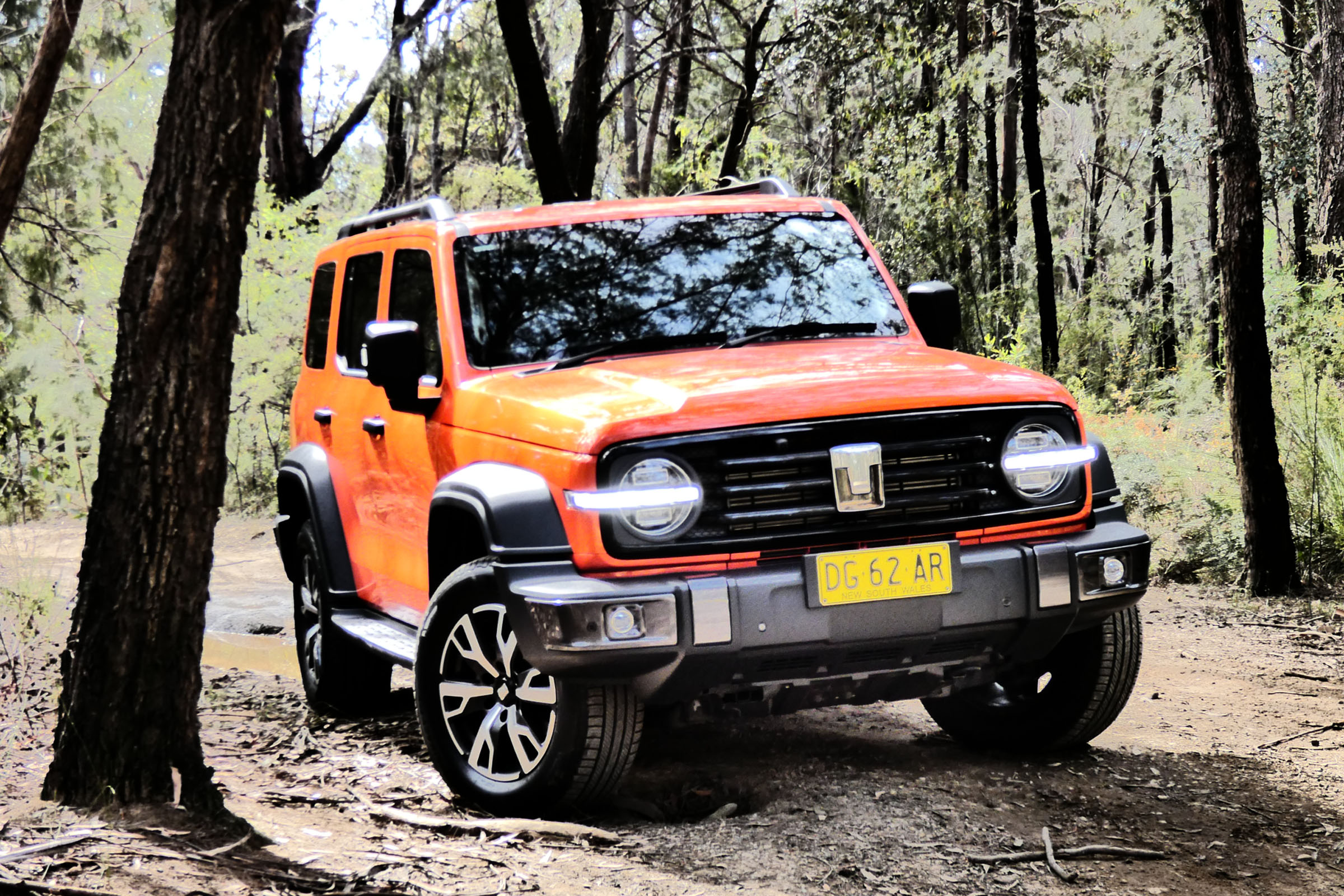
Tank, in all its connotations, seems a strange name for a peacetime passenger vehicle. Maybe it’s lost something in translation from its native Chinese? Be that as it may, the maker Great Wall Motors as seen fit thus to designate its ‘300’ and ‘500’ SUVs.
The new Tank 300 is the third of the 300s and the first pure petrol model. The previous pair being petrol / electric hybrids. Described by GWM as ‘rugged and refined’ (Rambo in carpet slippers, perhaps), the Tank 300 couple come in Lux and Ultra spec (on test), selling for $46,990 and $50,990 respectively, drive-away.
Apart from price and giving up something in size, this puts the Tank up against the Jeep Wrangler, Mitsubishi Sport, Isuzu MU-X and Toyota Fortuner.
Stepping up to the Tank 300 Lux Hybrid costs from $55,990 before on-road costs, while the range-topper is the Ultra Hybrid from $60,990.
Powered by a 162kW 2-litre turbocharged engine mated with an eight-speed automatic transmission, putting power to ground via a part-time four-wheel drive system, the Tank 300 Ultra adds a front diff lock to that of the lower spec Lux with its rear only, so with all-terrain selection and crawl mode it is kitted out to take part in some off-road action.
Like all GWM products, the Tank 300 is covered by a seven-year unlimited kilometre factory warranty, plus five years’ roadside assistance and similar period capped-price servicing, set for every 12 months or 10,000 kilometres.
STYLING
Retro in styling, there’s a vein of Jeep running through the Tank 300, with a similar solid, muscular frame that’s both functional and eye-catching.
Sidesteps ease cabin access, sunroof opens up the living area and roof rails are, well, roof rails. And the Ultra has it over its sibling Lux with 18-inch silver alloy wheels as opposed to 17s.
Lighting front and back is up with the latest in automotive LED technology.
INTERIOR
The European designed cabin is a classy environment for five occupants, topped off by dark Nappa leather accented seats, heated and cooled up front. However, the passenger side is let down badly by a cheap-and-nasty contrasting grey plastic panel across a large length of dash.
The driver fairs better with an eight-way adjustable seat with lumbar support and massage function. The split tailgate is side-hinged barn-style below with vertical-lift window above, where a welcome full-size spare wheel is worn on the outside.
Cargo space is limited for such an SUV – 400 litres when the second-row seat backs are up, and 1635 litres when they are folded. Leg room is comfortable enough for four occupants (five at a pinch) and back seaters will welcome dual USB-A ports.
INFOTAINMENT
Two 12.3-inch screens make an impressive dashboard display of instruments and infotainment, the touchscreen summoning up top quality Apple CarPlay and Android Auto connectivity. Wireless phone charging and 220V power outlet are a bonus.
Nine-speaker audio is standard across the range, with ‘home brand’ speakers in the Lux grade and Infinity premium quality in the Ultra. Advanced auto tech is reflected in an auto-dimming rear-view mirror, while ambient lighting shines with 64 colours to choose from.
ENGINES / TRANSMISSIONS
The 2-litre turbo petrol engine delivers a maximum 162kW at 5500 rpm and 380Nm of torque between 1800 and 3600 revs. This is mated with an eight-speed automatic transmission and part-time four-wheel drive.
SAFETY
Across the range, the Tank 300 earned a five-star from 2022 ANCAP testing, which features seven airbags, including front centre. Active safety takes in autonomous emergency braking and forward collision warning, lane departure warning, lane keeping assist, turning assist, plus adaptive cruise control.
Other systems include traffic sign recognition, rear cross-traffic alert with braking, front and rear parking sensors and 360-degree camera.
DRIVING
The 2.0-litre, four-cylinder turbocharged petrol engine coped adequately with the day-to-day running of family business, the eight-speed automatic working well within its limits.
It was relatively quiet, too unless there was a need to crank up the acceleration.
Fuel economy of 9.5 litres per 100 kilometres is claimed in the combined urban / highway cycle. On test, the best was 7-plus.
Riding on a ladder chassis the double wishbone suspension up front and independent multi-link behind offered a firm but ‘more planted than harsh’ ride. Towing rates are 2500kg with a braked trailer and 750kg unbraked.
SUMMARY
Looking beyond the name, the Tank 300 turns out to be a retro-styled on-road family wagon of quality materials and craft with the ability to tackle above-average tough going off the bitumen.
The Ultra is a genuine leader.
RATINGS
Looks – 8
Performance – 7
Safety – 7
Thirst – 5
Practicality – 7
Comfort – 8
Tech – 7
Value – 8
AT A GLANCE
MODEL LINE-UP (Drive-away prices)
Tank 300 Lux petrol: $46,990
Tank 300 Ultra petrol: $50,990
Tank 300 Lux hybrid: $55,990
Tank 300 Ultra hybrid: $60,990
Options: Premium paint $595
SPECIFICATIONS (GWM Tank 300 2.0-litre four-cylinder turbo petrol, 8sp, part-time 4WD)
ENGINE
Capacity: 1967cc
Configuration: four cylinders inline
Maximum power 162kW @ 5500rpm
Maximum torque: 380Nm @ 1800-3600rom
Fuel type: Petrol 91 RON
Combined fuel cycle: (ADR 81/02) 9.5L/100km
Fuel tank: 75L
DRIVELINE: Eight-speed torque converter automatic, part-time 4WD
DIMENSIONS, WEIGHT, AND CAPACITIES
Length: 4760mm
Width: 1930mm
Height:1903mm
Wheelbase:2400mm
Kerb weight: 2750kg
Turning circle: 12.0m
BRAKES
Front: Ventilated disc
Rear: Ventilated disc
STANDARD WARRANTY
Seven years / unlimited kilometres
Five years roadside assist
(ends)